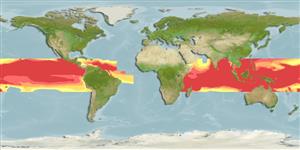Common names from other countries
Issue
Issue on validity of subspecies: subspecies considered as valid in FB, elevated to species rank as Oxyporhamphus micropterus (Valenciennes, 1847) in Eschmeyer (CofF ver. Mar. 2011: Ref. 86697). Please send references, or more studies are needed.
Environment: milieu / climate zone / depth range / distribution range
Ecologia
marinhas; oceanódromo (Ref. 51243); intervalo de profundidade 0 - 1 m (Ref. 58302). Tropical; 20°N - 20°S
Indo-Pacific: East Africa to Tonga, north to southern Japan (Ref. 33390). Eastern Pacific: Mexico to Peru (Ref. 9306). Replaced in the Atlantic by Oxyporhamphus similis.
Length at first maturity / Tamanho / Peso / Idade
Maturity: Lm 12.8, range 13 - 13 cm
Max length : 18.5 cm SL macho/indeterminado; (Ref. 9843)
Espinhos dorsais (total): 0; Raios dorsais moles (total): 13-15; Espinhos anais 0; Raios anais moles: 13 - 16; Vértebras: 47 - 50. Adults with a single large chamber to the swim bladder. Average number of gill rakers on the first arch, 30.7; predorsal scales, 31.1 on the average. Branchiostegal rays: 11-14 (Ref. 36576).
A true oceanic species, not bound to coastal waters at any period of its life (Ref. 9843).This species is the only halfbeak which doesn't have an extended lower jaw at the adult phase (Ref. 9306). Oviparous, with planktonic eggs and larvae (Ref. 36576).
Collette, B.B., 1986. Hemiramphidae. p. 388-391. In M.M. Smith and P.C. Heemstra (eds.) Smiths' sea fishes. Springer-Verlag, Berlin. (Ref. 4164)
Categoria na Lista Vermelha da IUCN (Ref. 130435)
CITES (Ref. 128078)
Not Evaluated
Ameaça para o homem
Harmless
Utilização humana
Mais informação
ReferênciasAquaculturaPerfil para aquaculturaEstirpesGenéticaElectrophoresesHereditariedadeDoençasProcessamentoMass conversion
Ferramentas
Relatórios especiais
Descarregue XML
Fontes da internet
Estimates based on models
Preferred temperature (Ref.
115969): 26.3 - 29.2, mean 27.9 (based on 25608 cells).
Phylogenetic diversity index (Ref.
82804): PD
50 = 0.7500 [Uniqueness, from 0.5 = low to 2.0 = high].
Bayesian length-weight: a=0.00324 (0.00148 - 0.00710), b=3.08 (2.90 - 3.26), in cm Total Length, based on LWR estimates for this (Sub)family-body shape (Ref.
93245).
Nível Trófico (Ref.
69278): 3.1 ±0.15 se; based on food items.
Resiliência (Ref.
120179): Elevada, tempo mínimo de duplicação da população menor que 15 meses (K=1.0).
Fishing Vulnerability (Ref.
59153): Low vulnerability (15 of 100).
